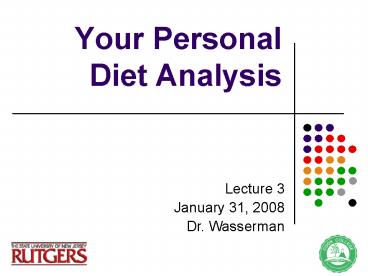Your Personal Diet Analysis - PowerPoint PPT Presentation
1 / 30
Title:
Your Personal Diet Analysis
Description:
To evaluate your own diet by comparing your personal nutrient intake to Dietary ... Use information from your Diet Analysis Printout. Pay attention to units ... – PowerPoint PPT presentation
Number of Views:508
Avg rating:3.0/5.0
Title: Your Personal Diet Analysis
1
Your Personal Diet Analysis
Lecture 3 January 31, 2008 Dr. Wasserman
2
Purpose of Assignment
- To evaluate your own diet by comparing your
personal nutrient intake to Dietary Reference
Intakes (DRIs) for nutrients, and dietary
guidelines, which set limits for dietary
components such as fat, saturated fat,
cholesterol.
3
The Project consists of 3 Parts
- Part I Diet Analysis
- A. Collection of Data
- Recording food intake
- B. Processing Data
- Using Diet Analysis Plus 8.0 Program (DA)
- C. Printing Reports
- Part II Diet Questionnaire
- Interpreting Results of the Diet Analysis
- Part III Submission of Project
4
Collection of Data Recording what you eat ON
PAPER
- Choose 3 consecutive days to record food intake
- One (1) weekend day must be included
- Be sure to record all food and liquids consumed
- Include all meal items and snacks
- Use one Food Record Sheet per day
- This is a diary (your log) of what you ate
- For each food consumed, record
- the time and item consumed
- description of the item (boiled, fried, diced,
etc.) - portion size
Do not include any vitamin/mineral supplements in
your food record
5
Food Record (available on class website 2/4)
6
Recording Food Intake Data
7
Help Estimating Portion Sizes
- Measure, if possible
- Check net weights and portions on packaging
- Estimating Tips
- 1 cup a baseball
- 1 ounce cheese four dice
- 3 ounces meat deck of cards
- 1 ounce nuts one handful
- 1 ounce chips two handfuls
8
Estimating Serving Sizes
9
Example Sample Food Record
10
B. Processing Data Where you input what you ate
and the program converts your food record data
into all the nutritional details
- What you need to do
- Tell the computer who you are
- Setting up your profile
- Input your Food Record into the program
- Processing Data
- Print Reports
11
How to get started
12
Setting up Your Profile
- Enter student information
- Enter profile data
13
How to get started
Enter student information
14
Setting up Your Profile
Activity Level Profile
Enter profile data
15
B. Entering Food Record Data
- Enter all foods from Record
- Common Errors to Avoid, examples
- Coffee Cream
- Orange Juice concentrate
- Tea, powdered, instant
- French Fry SVG
- Bag of Chips - 7.5 oz. vs. 1 oz.
16
Track your Diet!
17
Serving Size (not super size)
18
How big is a serving?
19
Foods Eaten
20
Viewing Reports
- Compare results to input
- Do they make sense?
- Quality Control Check!
21
Intake vs.Goals
22
C. Printing Reports
- Select Custom Average Reports
- Print out only
- Profile and DRI Goals
- Macronutrient (energy nutrient) ranges
- Fat breakdown ( fats of your total kcals)
- Intake vs. Goals
23
Print Reports
24
Custom Average Reports
checked
UNchecked
25
Diet Analysis Plus Support
If you experience any issues with using Diet
Analysis 8.0, simply visit http//www.thomsonedu.
com/support
26
Part II. Diet Questionnaire
Interpreting Results
- Print out questionnaire
- Answer all questions
- Use information from your Diet Analysis Printout
- Pay attention to units
- To understand DRIs and Dietary Guidelines see
Ch. 2, pgs. 36-39 in text.
- Available on class website on Jan. 31st
- http//foodsci.rutgers.edu/fs104
27
Dietary Reference Intakes (see inside of
textbook cover)
- Analysis includes
- RDAs for 9 vitamins, 3 minerals and protein.
(by weight) - AIs for 1 vitamin, 3 minerals, fiber, water and
omega fats. (by weight) - Acceptable Macronutrient Distribution Ranges
(AMDR) for carbs, fat and protein. (as a percent
of kcalories).
28
Dietary Guidelines
- Limit non essential components of the diet such
as - Saturated fat
- Cholesterol
- Added sugar, sweeteners
- Alcohol
29
Understand the Math Example
- 1 cup of 2 milk
- weighs 250 grams
- has 125 kcals
- Calculations
- How many grams of fat ? (hint 2 fat)
- .02 x 250 grams 5 grams of fat
- How many kcals from fat? (hint 9 calories/g for
fat) - 5 g x 9 kcals/ g 45 kcals
- What of kcals come from fat? (hint ratio)
- 45 kcals /125 kcals x 100 36
30
Part III. Submission of Project
- What do You Hand In?
- Your profile (1st page ONLY) 1 page
- Food records 3 pages
- Printouts of entered food lists 3 pages
- 3-Day Average printouts
- Macronutrient (energy) ranges 1 page
- Fat breakdown 1 page
- Intake vs. Goals 1 page
- Completed Questionnaire 6 pages
- Completed Questionnaire Total 18 pages
31
III. Submission of Project How / When to Submit
- DUE in class March 13th
- Extra 10 pts. for submitting on Feb. 28th
- MAKE A COPY of the entire assignment
- Place report in 9x12 manila envelope
- WRITE CLEARLY in upper right corner of envelope
- Name student number
- Email address
- Course 400104
32
Grading
- Data 10 pts.
- Reports 10 pts.
- Questionnaire 80 pts.































